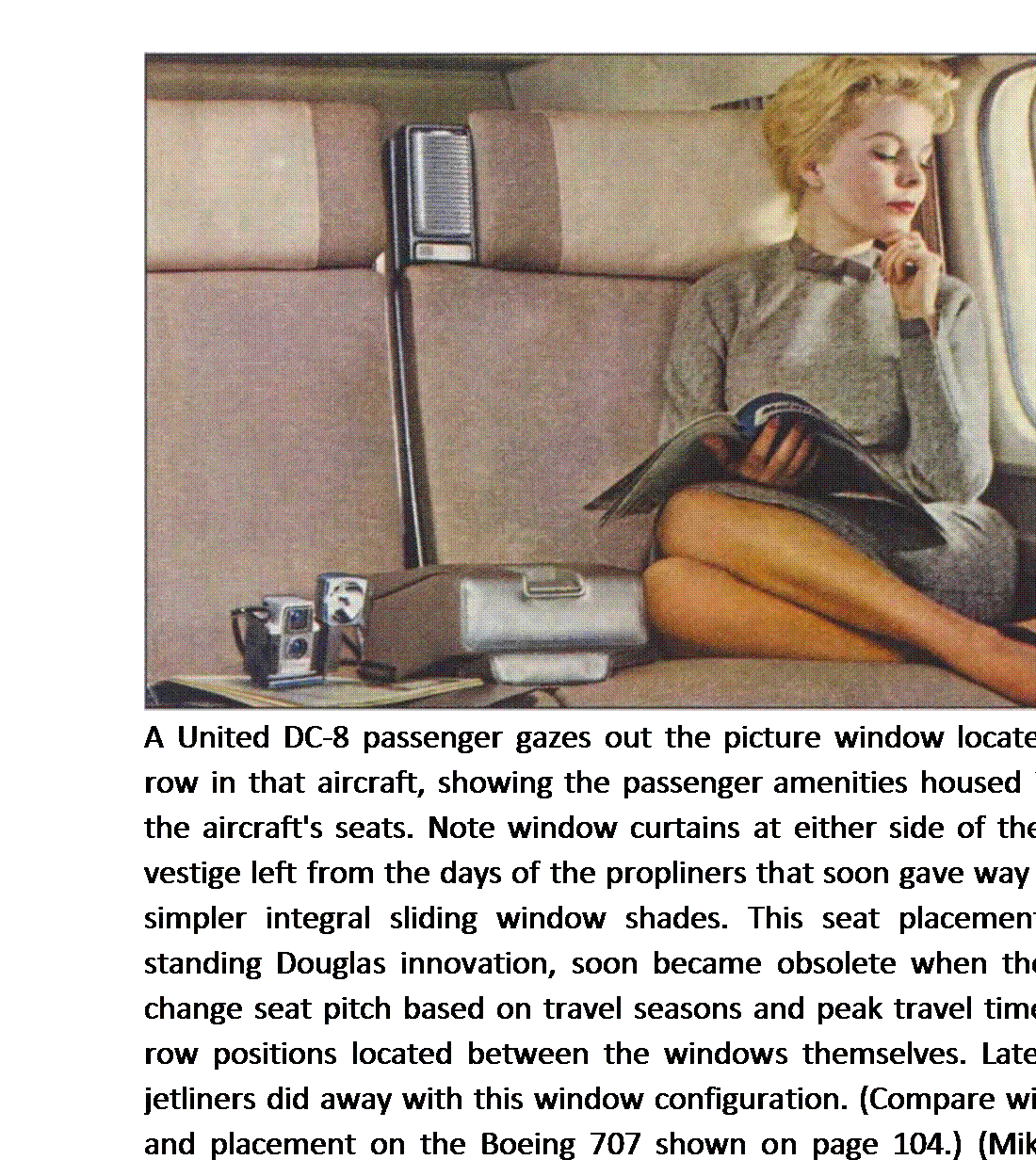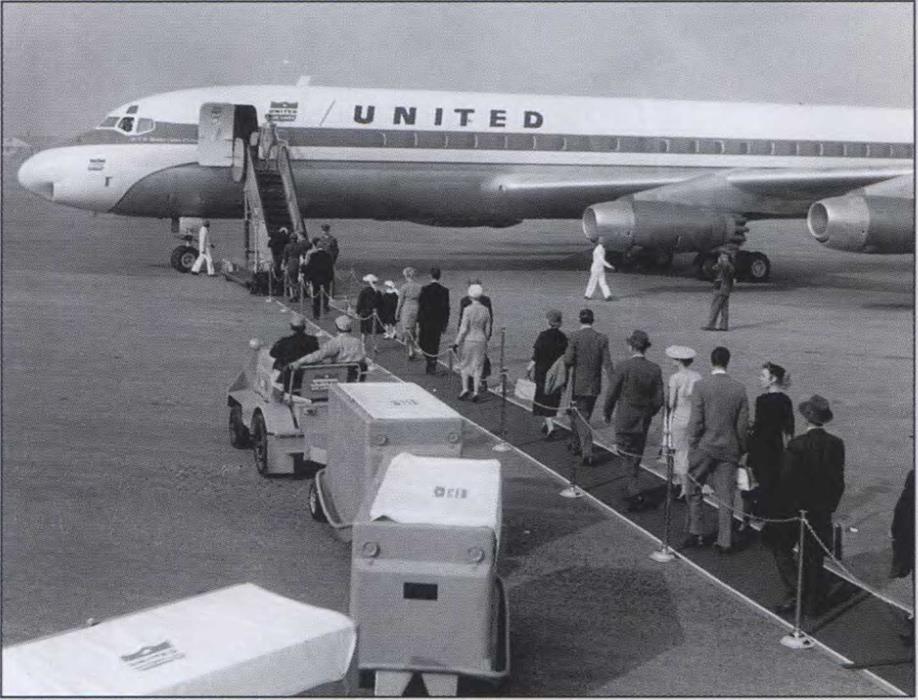WELCOME ABOARD THE DC-8
By Craig Kodera
|
W |
hat an exciting time to be flying commercially: 1960. The Boeing 707 has made its debut and is now plying the airways, having beaten the Douglas DC-8 into service by a year. But the -8 was something special, and as the Douglas sales folks were saying, well worth the wait.
Until then, Douglas had been the undisputed leader in commercial airline transport aircraft, while Boeing built bombers. Douglas may not have been first, but the company learned from others’ mistakes and refined the jetliner concept. What emerged was a beautiful engineering accomplishment, which was designed to make both passengers and airline bosses happy.
When approaching the DC-8, a passenger cannot help but notice the height of the airplane, especially since it sat up on its main landing gear with a nose – down attitude. One could readily see this because the world was still utilizing external boarding stairs on a ramp outside a terminal. This only served to increase the juxtaposition of flight experiences between the props and the jets.
One other attention grabber was the “translating rings/ejectors” or reverser rings for each engine, designed to slide back on rails in the lower pylon while the airplane was in a landing configuration. Interestingly, this feature accomplished two other actions: noise suppression and inflight drag inducement much like using spoilers to help increase descent rate without increasing airspeed.
Upon entering the cabin, a Douglas design feature immediately presents itself in the form of a forward lounge, placed in a dedicated space ahead of the main cabin. Much like the DC-6B and DC-7, the forward lounge had its own distinctive pair of windows. Decor was late-1950s chic, with vinyl upholstery and “space-age” colors and shapes in the furnishings. How delightful it will be to visit this area during our flight.
Arriving in our first-class cabin, we notice the unique Douglas-designed Palomar seats. These seats were state of the art at the time, and had in their headrests all of the passenger service unit amenities, rather than mounting them overhead. It was just one more way the DC-8 engineers tried to pamper Jet Age passengers.
But by far the most wonderful aspect of flying in a DC-8 was its windows. Those wonderful, expansive
|
|
Passengers board a United Douglas DC-8-21 in this carefully staged publicity photo taken at Long Beach Airport in 1958. In the foreground is a baggage tug with carts of individual baggage containers that held luggage and small cargo and were hoisted up into the under-floor baggage bays forward and aft of the wing. This novel Douglas feature became the standard method of baggage loading many years later as wide-body transports made their debut. Note the carpet and stewardess positioned atop the boarding stairs ready to welcome everyone onboard. (Craig Kodera Collection)
|
Jet flight in the Stratosphere at 600 mph was as futuristic as it got in 1960, and this view from the window of a Pan Am DC-8 shows you why. (Allan Van Wickler) |
windows were the largest on any jetliner. Thankfully this design feature was held over from DC-6 and -7 days, and we are sure to have a wonderful sightseeing trip in the DC-8 as a result.
 Once underway, the airplane has the feeling of being rock-solid. The movement is hardly noticeable. Then the sound of the JT3 engines comes alive as they begin spooling-up for takeoff, the soft turbine whine settling into a low rumble. We’re off and on our way on Douglas-firm wings. You never have to worry about the structural integrity of a Douglas airliner.
Once underway, the airplane has the feeling of being rock-solid. The movement is hardly noticeable. Then the sound of the JT3 engines comes alive as they begin spooling-up for takeoff, the soft turbine whine settling into a low rumble. We’re off and on our way on Douglas-firm wings. You never have to worry about the structural integrity of a Douglas airliner.
Having enjoyed all the passenger comfort items we had found on a DC-8, we realize our time in the air is almost at an end. As the flight draws to a close we notice that during our descent the DC-8 is a very “slick” aircraft design, one that can easily overrun an airport without careful planning by the cockpit crew. And here come those reversers now! On the ground with a solid touchdown, we can thank Douglas for another fine airplane. The Jet Age is certainly here, and the ride is wonderful.
Only Delta and United purchased DC-8-10s, with a total of 28 being built. Within four years, both carriers had begun upgrading them to turbofan-powered
DC-8-50s.
In much the same way as Boeing hatched the 707- 200 series, Douglas created its DC-8-20 by upgrading the -10 airframe with the more powerful Pratt & Whitney JT4A turbojets planned for the long-range DC-8-30. This resulted in an airplane tailored for operations into hot and high-altitude airports, with an increased maximum takeoff weight of 276,000 pounds. Aeronaves de Mexico, Eastern, National, and United bought a total of 34 airframes. In addition, United upgraded 15 DC-8-10s to the Series 20 standard.
The first factory-delivered example was accepted by Eastern Air Lines on January 3, 1960, and entered service on January 20, advertised as the DC-8B, a designation once marketed by the manufacturer and what seemed like a natural follow-on to Eastern’s DC-7B Golden Falcon service. Following a complaint to the CAB by Delta, however, Eastern was ordered to drop the “B” designation for the DC-8.
National Airlines initiated DC-8-20 service on February 11 between New York and Miami, technically becoming the first airline to simultaneously operate
both the 707 and DC-8 by virtue of its 707 leasing agreement with Pan Am.
For long-haul operations the basic DC-8 airframe was equipped with uprated JT4A-9, 16,800-pound – thrust engines, and fuel capacity was increased from
17,500 gallons to 23,400 gallons, creating the DC-8-30 series. Pan Am’s Chairman Juan Trippe, who insisted on having the more robust powerplant to gain the international range his airline’s routes required, ordered it first. The JT4A was a civil version of Pratt & Whitney’s new J75 turbojet being used in several of the Air Force’s new supersonic Century Series fighters at the time.
Unlike the long-range 707-320, the DC-8’s fuselage was not stretched, nor was its wing area enlarged, but maximum takeoff weight was increased to between
300,0 and 315,000 pounds depending on the variant (-31/-32/-33). These changes increased its range to 4,700 miles, resulting in transatlantic capability, even to southern European destinations. Fifty-seven DC-8-30s were sold to 10 airlines including U. S. carriers Northwest and Pan American, which was first to put the type into service on March 27, 1960, between New York and Bermuda, and then later to Europe and South America.
The DC-8-40 variants (-41/-42/-43) were identical to the respective DC-8-30 series, but powered by
17,500-pound thrust Rolls-Royce Conway R. Co.12 bypass engines. Thirty-two were delivered to Alitalia, Canadian Pacific, and Trans-Canada Airlines. TCA accepted the first Series -40 on February 4, 1960, and began service on April 1 between Toronto and London via Montreal.












